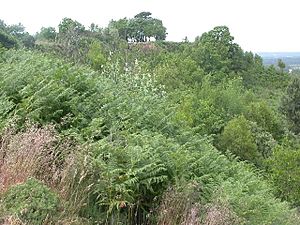Caesar's Camp, Rushmoor and Waverley facts for kids
Caesar's Camp is an ancient hill fort from the Iron Age. It's located on the border of Surrey and Hampshire in southern England. This important historical site is about 3 kilometers (2 miles) north of Farnham and west of Aldershot.
Caesar's Camp is a Scheduled Ancient Monument. This means it's a protected historical site. The fort is known for its multiple defensive rings. This type of fort is called a "multivallate" hillfort. It's built on a high piece of land, and its main entrance is on the south side. The area around the fort is also a Site of Special Scientific Interest, protecting its natural environment.
Contents
Exploring Caesar's Camp's Past
How the Fort Developed Over Time
Caesar's Camp might have started in the Late Bronze Age. It was likely a fort connected to the River Wey. During the Iron Age, the fort went through three main building stages.
- First Stage: It began as a simple "univallate" fort. This means it had only one defensive ring.
- Second Stage: The defenses were made stronger. They added more rings, making it "multivallate." A wooden fence, called a palisade, was also built.
- Third Stage: A large earth bank was built over the old wooden fence. This made the defenses even stronger.
After the Iron Age, people stopped using the fort for a long time. Later, in the medieval period, a park was created around it. The old Iron Age defenses were used as part of the park's boundary. In the 11th century, Caesar's Camp belonged to the Bishop of Winchester. By the 13th century, it was part of a park for Farnham Castle.
What Caesar's Camp Looks Like Today
Location and Natural Features
Caesar's Camp stands 177 meters (581 feet) above mean sea level. The ground on the northern slopes is made of sand. The area around the fort has wide open heathland. A modern quarry has damaged the defenses on the east side.
The inside of the fort is mostly untouched. It's rare to find such a large multivallate Iron Age fort. Because of this, Historic England considers Caesar's Camp to be very important for the country.
Understanding the Fort's Defenses
The fort is quite large, covering about 10.5 hectares (26 acres). Its earth walls, called ramparts, and ditches mostly follow the shape of the hill.
- South Side: The strongest defenses are here. They cut across flat ground.
- North and Northeast Sides: These sides have very steep slopes. Because of this, no earth defenses were needed there.
- Southwest Side: Marshland was used as part of the defenses. There are some gaps in the ramparts in this area.
- East Side: The defenses here had two ramparts.
- The inner rampart is 10 meters (33 feet) wide and 3 meters (10 feet) high.
- The ditch between the ramparts is 2 meters (7 feet) deep and 5 meters (16 feet) wide.
- The outer rampart is 6 meters (20 feet) wide and 2 meters (7 feet) high.
- Outside the second rampart is another ditch, about 1 meter (3 feet) deep.
- Southeast Side: This part had three ramparts. It also had an extra bank that continued to the south side.
Entrances and Other Features
Experts believe the main entrance to the fort was in the middle of the east side. However, modern quarrying has damaged this area, so it's hard to be sure. A trackway cuts through the strong defenses on the south side, but this might be a modern path.
You can still see parts of the medieval park boundary. It looks like a bank and a ditch along the western edge of Caesar's Camp. The bank is 2 meters (7 feet) wide and 1 meter (3 feet) high. The ditch is 2.5 meters (8 feet) wide and 0.5 meters (2 feet) deep.
Discoveries at Caesar's Camp
What Archaeologists Have Found
In 1983, an archaeologist named N. Riall dug a small trench, about 15 square meters (161 square feet). This helped them learn more about the site.
Other interesting items have been found at Caesar's Camp:
- A Roman roof tile was discovered. It is now kept at Camberley Museum.
- An early rapier (a type of sword) from the Middle Bronze Age was also found. This sword is very old, dating back to around 1500–1000 BC.
Details of the Bronze Age Sword
The Bronze Age sword is made from a copper alloy. It has a special design with a fluted blade and three ribs in the middle.
- It is 305 millimeters (12 inches) long.
- The blade is 19 millimeters (0.7 inches) wide.
- It is 7 millimeters (0.3 inches) thick.
- The hilt (handle) plate is 48 millimeters (1.9 inches) wide.
This ancient sword is now displayed at the British Museum.
Images for kids



